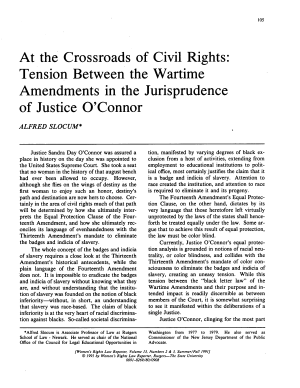At the Crossroads of Civil Rights: Tension Between the Wartime Amendments in the Jurisprudence of Justice O'Connor
January 1991

DISCLAIMER: This text has been transcribed automatically and may contain substantial inaccuracies due to the limitations of automatic transcription technology. This transcript is intended only to make the content of this document more easily discoverable and searchable. If you would like to quote the exact text of this document in any piece of work or research, please view the original using the link above and gather your quote directly from the source. The Sandra Day O'Connor Institute does not warrant, represent, or guarantee in any way that the text below is accurate.
Article Text
(Excerpt, Automatically generated)
At the Crossroads of Civil Rights: Tension Between the Wartime Amendments in the Jurisprudence of Justice O'Connor
ALFRED SLOCUM*
Justice Sandra Day O'Connor was assured a place in history on the day she was appointed to the United States Supreme Court. She took a seat that no wqman in the history of that august bench had ever been allowed to occupy. However, although she flies on the wings of destiny as the first woman to enjoy such an honor, destiny's path and destination are now hers to choose. Cer tainly in the area of civil rights much of that path will be determined by how she ultimately inter prets the Equal Protection Clause of the Four teenth Amendment, and how she ultimately rec onciles its language of evenhandedness with the Thirteenth Amendment's mandate to eliminate the badges and indicia of slavery.
The whole concept of the badges and indicia of slavery requires a close look at the Thirteenth Amendment's historical antecedents, while the plain language of the Fourteenth Amendment
-does not. It is impossible to eradicate the badges and indicia ofslavery without knowing what they are, and without understanding that the institu tion of slavery was founded on the notion of black inferiority-without, in short, an understanding that slavery was race-based. The claim of black inferiority is at the very heart of racial discrimina tion against blacks. So-called societal discrimina-
tion, manifested by varying degrees of black ex clusion from a host of activities,
